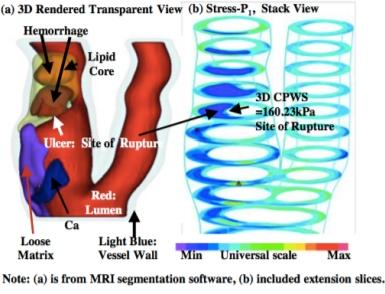Image-Based Computational Mechanical Analysis and Indexing for Cardiovascular Diseases
Cardiovascular disease is the number one killer in the United States. A large number of victims die without showing any prior symptoms or before they reach the hospital. The majority of all myocardial infarctions are caused by the rupture of a vulnerable plaque. It has been hypothesized that mechanical risk factors may be used to predict future atherosclerotic plaque ruptures.
Current diagnostic technology, such as MRI, CT, and ultrasound equipment, for certain cardiovascular diseases (e.g., carotid plaque rupture, coronary plaque rupture, and aneurism rupture) lack accurate and reliable computational indices for use in physicians’ decision making processes, or the models are oversimplified.
The present invention addresses these deficiencies with a novel combination of computational and statistical models. The system uses serial MRIs to quantify sensitivity and specificity of mechanical predictors to identify the best candidate for plaque rupture site prediction.

Key Features/Benefits
- The 3D model of the organ includes both fluid structure (e.g., blood vessel interactions) and the structure of the organ, while current technology only employs one of these factors.
- The mechanical biological indices quantify the degree of the disease status, which helps physicians in the decision making process.
- The invention is applicable to various diseases, not only cardiovascular diseases.
- The invention may be used in computer-guided heart surgery.
- Future cardiac episodes can be predicted and controlled to prevent their occurrences.